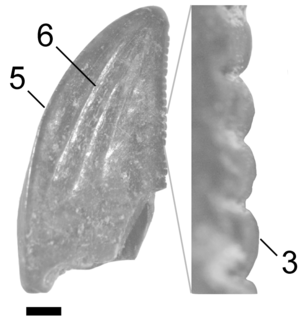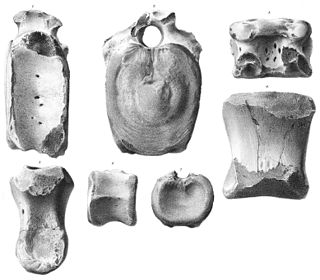
Agathaumas is a dubious genus of a large ceratopsid dinosaur that lived in Wyoming during the Late Cretaceous. The name comes from Greek, αγαν - 'much' and θαυμα - 'wonder'. It is estimated to have been 9 metres (30 ft) long and weighed 6 tonnes, and was seen as the largest land animal known at the time of its discovery.

Zapsalis is a genus of dromaeosaurine theropod dinosaurs. It is a tooth taxon, often considered dubious because of the fragmentary nature of the fossils, which include teeth but no other remains.

Paronychodon was a theropod dinosaur genus. It is a tooth taxon, often considered dubious because of the fragmentary nature of the fossils, which include "buckets" of teeth from many disparate times and places but no other remains, and should be considered a form taxon.
Polyonax was a genus of ceratopsid dinosaur from the late Maastrichtian-age Upper Cretaceous Denver Formation of Colorado, United States. Founded upon poor remains, it is today regarded as a dubious name.

Thespesius is a dubious genus of hadrosaurid dinosaur from the late Maastrichtian-age Upper Cretaceous Lance Formation of South Dakota.

Cionodon is a dubious genus of hadrosaurid dinosaur from the Late Cretaceous. The type species, C. arctatus, was found in the Denver Formation of Lodge Pole Creek, Colorado and was formally described by Edward Drinker Cope in 1874 based on the holotype AMNH 3951, collected in 1873. It is a nomen dubium because it is based on very fragmentary remains. Two other species have since been described: Cionodon kysylkumensis, based on the holotype CCMGE 1/3760 from Uzbekistan, and Cionodon stenopsis, discovered in rocks from the Judith River Formation of Alberta, Canada in 1874. Although both are probably hadrosaurs, they are known only from fragmentary remains and Cionodon kysylkumensis has since been reclassified as Bactrosaurus kysylkumensis.
Diclonius is a genus of dinosaur from the Late Cretaceous. It was a hadrosaur based solely on teeth. Its fossils were found in the Judith River Formation of Montana, northern US. The name is in reference to the method of tooth replacement, in which newly erupting replacement teeth could be in functional use at the same time as older, more worn teeth. Thus, the number of "sprouting" teeth was doubled in comparison to Monoclonius, which used only one set of teeth at a time and which Cope named in the same paper.

Protostega is an extinct genus of sea turtle containing a single species, Protostega gigas. Its fossil remains have been found in the Smoky Hill Chalk formation of western Kansas, time-equivalent beds of the Mooreville Chalk Formation of Alabama and Campanian beds of the Rybushka Formation. Fossil specimens of this species were first collected in 1871, and named by Edward Drinker Cope in 1872. With a length of 3 metres (9.8 ft), it is the second-largest sea turtle that ever lived, second only to the giant Archelon, and the third-largest turtle of all time behind Archelon and Stupendemys.
Rhabdopelix is a dubious genus of possible kuehneosaurid reptile, from the Late Triassic-age Lockatong Formation of Pennsylvania, USA. Based on partial, possibly chimeric remains, it was described by American naturalist and paleontologist Edward Drinker Cope as an early pterosaur. It held this status until the 1960s, when Ned Colbert reevaluated it for his description of Icarosaurus. He noted that the bones came from a block with the remains of other animals, and that Cope had misinterpreted some of the remains; for example, the rod-like "pubic bones" that had given it its name were actually much more like the bony structures used by Icarosaurus and related animals to glide. Additionally, he couldn't relocate the fossils, which are assumed to be lost. He recommended considering Rhabdopelix a dubious name. Peter Wellnhofer retained it as a pterosaur of unknown affinities in his 1978 review, but rejected this by 1991.
Fresnosaurus is an extinct genus of plesiosaur from the Late Cretaceous of what is now California. The type species is Fresnosaurus drescheri, first described by Welles in 1943. The generic name Fresnosaurus honors Fresno County, while the specific name honors Arthur Drescher.

Crymocetus is an extinct genus of plesiosaur from the Cretaceous Chalk Group of Sussex, England. Since its description, it has been seldom examined by subsequent authors, except when mentioned in discussions of Cretaceous plesiosaurs

Sthenarosaurus is an extinct genus of rhomaleosaurid pliosauroid discovered in the Toarcian-aged 'Main Alum Shale' in Whitby, England. The type species, S. dawkinsi, was named and described in 1909. The type specimen is MMUM LL 8023, a set of postcrania discovered in Whitby. Other indeterminate specimens are known, including a pectoral girdle described in 1911.
This timeline of Cambrian research is a chronological listing of events in the history of geology and paleontology focused on the study of earth during the span of time lasting from 541 to 485.4 million years ago and the legacies of this period in the rock and fossil records.
This timeline of Ordovician research is a chronological listing of events in the history of geology and paleontology focused on the study of earth during the span of time lasting from 485.4–443.4 million years ago and the legacies of this period in the rock and fossil records.
This timeline of Silurian research is a chronological listing of events in the history of geology and paleontology focused on the study of Earth during the span of time lasting from 443.4–419.2 million years ago; the Silurian, and the legacies of this period in the rock and fossil records.
This timeline of Devonian research is a chronological listing of events in the history of geology and paleontology focused on the study of earth during the span of time lasting from 419.2 to 358.9 million years ago and the legacies of this period in the rock and fossil records.
This timeline of Permian research is a chronological listing of events in the history of geology and paleontology focused on the study of earth during the span of time lasting from 298.9–252.17 million years ago and the legacies of this period in the rock and fossil records.

This timeline of troodontid research is a chronological listing of events in the history of paleontology focused on the troodontids, a group of bird-like theropod dinosaurs including animals like Troodon. Troodontid remains were among the first dinosaur fossils to be reported from North America after paleontologists began performing research on the continent, specifically the genus Troodon itself. Since the type specimen of this genus was only a tooth and Troodon teeth are unusually similar to those of the unrelated thick-headed pachycephalosaurs, Troodon and its relatives would be embroiled in taxonomic confusion for over a century. Troodon was finally recognized as distinct from the pachycephalosaurs by Phil Currie in 1987. By that time many other species now recognized as troodontid had been discovered but had been classified in the family Saurornithoididae. Since these families were the same but the Troodontidae named first, it carries scientific legitimacy.

This timeline of coelophysoid research is a chronological listing of events in the history of paleontology focused on the coelophysoids, a group of primitive theropod dinosaurs that were among Earth's dominant predators during the Late Triassic and Early Jurassic epochs. Although formally trained scientists didn't discover coelophysoid fossils until the late 19th century, Native Americans of the modern southwestern United States may have already encountered their fossils. Navajo creation mythology describes the early Earth as being inhabited by a variety of different kinds of monsters who hunted humans for food. These monsters were killed by storms and the heroic Monster Slayers, leaving behind their bones. As these tales were told in New Mexico not far from bonebeds of Coelophysis, this dinosaur's remains may have been among the fossil remains that inspired the story.










